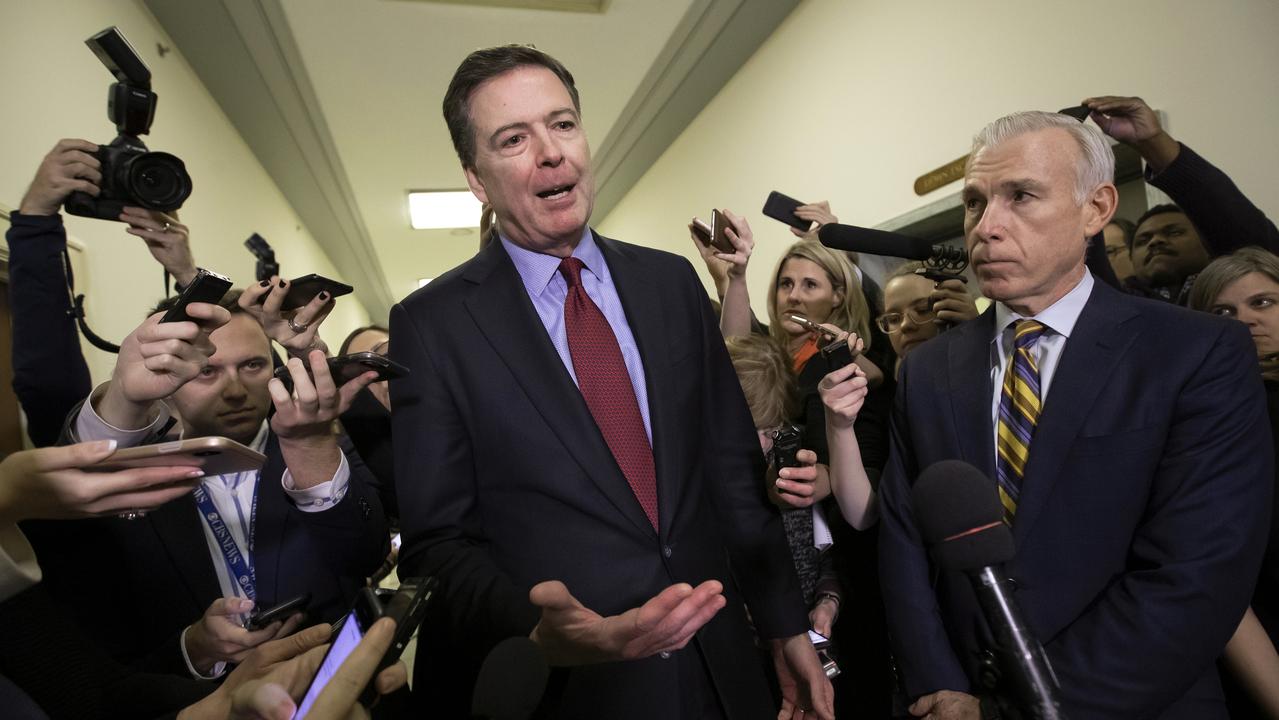Syria-Iraq mission can benefit from the lessons of Afghanistan
FOR a change, the Western coalition should picture the endgame and plan accordingly.

AUSTRALIANS go to war this week, almost 13 years to the day since the war in Afghanistan began on October 7, 2001. If those years teach us anything, itÂ’s that war is chaotic, its consequences profoundly destabilising and its outcomes impossible to predict.
But Afghanistan 2001 isn’t just a coincidental anniversary. It’s strongly analogous to today’s situation, with its combination of coalition air power and advisers, local boots on the ground, problematic politics and an uncertain endgame. Thus, while not predictive, “small-footprint” methods from the Afghan campaign suggest how this, the latest operation in a very long war, may play out.
Two months since airstrikes started in Iraq, the enemy is adapting. Islamic State, according to Western intelligence, is growing — 5000 fighters in January, 8000 in June, 15,000 a month ago, 30,000 today — but its tactics have changed. Instead of operating in the open, in daylight, with tanks and artillery, using mobile columns to seize cities, it has dropped into guerilla mode.
Islamic State fighters now work in smaller, stealthier groups, by night, underground, hiding ammunition in buildings such as mosques, which they assume are harder for aircraft to strike. They’re dispersing, ambushing and infiltrating new areas. Politically, they’re reaching out to local allies to build support.
These tactics are working. Despite setbacks — losing Mosul dam and the villages around Erbil, failing to encircle Mount Sinjar — Islamic State fighters are manoeuvring freely. Last week they routed the Iraqi army north of Fallujah; this week they renewed attacks on Baiji refinery, expanded into the belts around Baghdad and destroyed a large armoured column outside Ramadi.
In Syria and Lebanon, despite losses to airstrikes, Islamic State is expanding in Aleppo and Deir Ezzor, maintaining control of Raqqa and attacking into Lebanon and along the Syrian-Turkish border.
Most significantly, Islamic State is yet to be expelled from any major city it has seized. If anything, airstrikes are pushing it further into the cities, embedding it, turning some formerly pro-Western populations towards it as they suffer under coalition bombs.
Syrians are asking pointedly why the West bombs Jabhat al-Nusra, also known as al-Nusra Front (al-Qa’ida’s Syrian branch) and Islamic State while leaving the Assad regime — which has killed 200,000 Syrians — untouched, letting the Syrian army occupy Islamic State territory after airstrikes and strengthening the hand of a murderous dictator.
This suggests air power alone can’t defeat Islamic State; instead, an approach called “combined arms” is needed. Combined arms uses disparate forces, closely co-ordinated, to deliver a one-two punch, each force exposing weaknesses the other can target. In this case, ground troops stop enemy dispersing into cover and flush them out, letting aircraft target them. In turn, aircraft stop the enemy counterattacking, letting ground troops move forward to continue the process.
Done well, as in Afghanistan in 2001, this brings rapid results. In that campaign, US bombers and strike aircraft did most of the killing, enabled by Afghan ground forces that identified targets, forcing the Taliban to manoeuvre and reveal its positions. In turn, the aircraft protected ground troops, helping them seize territory. Within days, airstrikes allowed local forces to begin advancing; within a fortnight they were on a roll. The Taliban never came up with a way to counter these tactics — its last stronghold at Kandahar fell on December 7, only eight weeks after bombing began.
On that day there were a few hundred intelligence and special operations people in Afghanistan — but more than 50,000 Afghans fighting the Taliban.
For all its tactical brilliance, though, there are two problems in applying this model today.
First, policymakers have (publicly) ruled out putting troops into combat. But Afghan-style results would require troops in combat — a combination of special operations teams and joint terminal attack controllers (specialists in controlling airstrikes from forward positions). These would move into battle with local forces, designating targets, co-ordinating air support and offering advice.
In the business, this is called “advise, assist and accompany”. Today, support is limited to “advise and assist”, which permits training and logistics, but not combat advising or air control teams. Of course, as General Martin Dempsey, chairman of the US Joint Chiefs of Staff, noted in recent congressional testimony, this could change as things develop, so commanders are keen to keep this option open, even as politicians seem perplexingly eager to pre-emptively rule it out.
The second problem runs deeper. Local forces are in disarray: deeply in Iraq, near totally in Syria. The Iraqi army is losing most engagements, retreating when it can, getting slaughtered when it can’t.
The Sunni national guard is embryonic, maybe stillborn, unless Sunnis stifle their suspicion of a Baghdad government that betrayed them after the Awakening. Shia militias, though motivated, lack capability, and their politics make them unwilling to work with Western advisers.
Kurdish Peshmerga, despite a good recent showing, lack the heavy weapons and training to take on enemy tanks. It will take months to get this motley crew to where they could roll Islamic State back — especially since the guerillas are now in cities, and urban guerilla warfare demands another level of skills and equipment, as we spent years discovering the hard way in Iraq.
And that’s just on the Iraqi side of the border. The Free Syrian Army and its political parent, the Syrian National Coalition, lack support in Syria and have sketchy command and control — the SNC is based in Istanbul and the FSA has struggled to perform against Islamic State, while fighting hard — though often unsuccessfully — against Assad’s regime.
The largest nationalist rebel group next to the FSA, Harakat Hazm, has received Western training and weapons including TOW anti-tank missiles, but has only about 4000 fighters, making it too small to take on Islamic State with any chance of holding terrain or protecting population. Thus, getting ground forces ready to fight — a matter of months in Iraq — could take a year or more in Syria.
We’re starting from below zero too: many motivated, secular pro-democracy groups that flourished in 2011-12 have since been slaughtered or forced into extremism through lack of alternatives.
Thus, the likeliest coalition plan is a sustained bombing campaign in Syria and Iraq, lasting weeks to months, while advisers (including Australians) give Iraqi forces the training and equipment needed to fight Islamic State.
For now, training is slated for a base in Saudi Arabia, but it will also likely take place in Iraq. Sometime later this year, or early next year, we can expect an attempt to retake cities from Islamic State or (more likely) isolate them from outside.
Behind the scenes, there may be direct action by special operations forces, there will certainly be a quick reaction force to help coalition personnel in danger, and combat search and rescue teams will deploy to recover downed aircrew — so, while no combat units (infantry or armoured brigades) will be deployed, there will be plenty of combat action.
The coalition will offer intelligence, targeting and planning support, and will dispense arms and supplies while collecting data on those who receive them, lest they be used against us later.
In Syria, things will be similar but on a smaller scale, from a lower base and with a lower profile, since civilian agencies will be doing much of the work.
What there won’t be, in Iraq at any rate, is anything approaching the “nation-building”, civilian stabilisation or administration we engaged in last time, when the coalition focused on rebuilding Iraq, forming a democratic government and getting Iraq’s economy running.
These efforts — widely recognised as less than the sum of their parts — were part of our obligations as occupying powers under international law, following the overthrow of Saddam Hussein.
This time, Iraq has a sovereign — if not very stable or inclusive — government, and the coalition’s political effort will be focused on finding an accommodation to unite Sunni, Shia, Kurdish and ethnic-minority Iraqis into a functioning entity.
This will be extraordinary difficult. Prime Minister Haider al-Abadi’s new government will struggle to overcome mistrust after years of Shia-supremacist misrule; the US has extremely limited leverage to change this situation, and Iraqis (especially the Sunnis) know it.
Iran is playing a constructive role at present but, should ground operations spread to Syria or begin to threaten Tehran’s partners in Baghdad and Damascus, this could change overnight.
The best we can hope for in Iraq therefore may be a decentralised state offering extensive autonomy to its regions; perhaps even a de facto partition.
We’re unlikely to see a formal partition, which could start a region-wide unravelling of borders, or (conversely) the reintegration of Iraq into a functioning unitary state. That opportunity has probably passed, after everything that has happened.
If Iraqi politics are problematic (and they are), Syrian politics are far more so. President Bashar al-Assad claims his opponents are extremists, that whatever we may think of him, he’s the lesser of two evils. This was a barefaced lie at the start of the war, when the opposition consisted largely of secular, pro-democracy, peaceful protesterss, Arab Spring-style.
By 2012 this civil opposition movement had been destroyed with extreme brutality and its survivors forced into insurgency; by last year the West’s failure to offer meaningful support had pushed many rebels into extremism; by this year, Islamic Front, al-Nusra and others at the jihadist end of the spectrum had gained ascendancy in the opposition, in part because of their political consistency, in part because of their military prowess, but mainly by default.
So Assad’s lie of 2012 became the truth in 2014 — his opposition today really is largely composed of Salafi jihadist groups. And after the US’s conspicuous and embarrassing failure to act in September last year after Assad’s flagrant, large-scale use of chemical weapons against his own people, airstrikes now against Islamic State and other rebel groups ring pretty hollow for Syrians.
So the real dilemmas of this war lie not in Iraq but in Syria. If we succeed in pushing Islamic State to the Syrian border, what then? Do we keep going?
If we destroy it only to have Assad and the Iranians fill the vacuum, how would that help ordinary Syrians? Why would any sane Syrian rebel support that effort? Why would any regional Arab state accept that outcome?
And if — in the best imaginable outcome — we succeeded in building a pro-Western Syrian opposition, defeating Islamic State and forcing a transition to a democratic government, what then? We’d find ourselves (as in Afghanistan after 2001) with a peace process, a long and immense national reconstruction and stabilisation challenge, opposition from Hezbollah, Iran and Russia, and probably an ongoing jihadist insurgency.
And that’s the final, most important, analogy between today’s conflict and the Afghan campaign of 2001. The brilliance of the small-footprint approach that took down the Taliban in only eight weeks was followed by a failure to make peace, to commit seriously to political reconstruction, or to face the reality of complex cross-border politics in Pakistan.
Ultimately, this combination of failures doomed the effort: by 2003 we faced a resurgent Taliban, cross-border infiltration from Pakistan, and a protracted and problematic stabilisation effort that continues today.
Laying out a military campaign to deal with Islamic State is not exactly easy, and it certainly won’t be quick or bloodless, but it’s far easier than grappling with the complex questions of “what then?” and “what next?”
This uncertain strategic endgame is where we need to focus our intellectual energy now, to conceptualise what an acceptable post-conflict environment looks like, so that we can begin building the regional and global consensus and marshalling the resources, players and political will needed to deal with it.
Unlike last time, we need to consider that endgame, and plan backward from it. Otherwise we may find ourselves, another 10 — or 13 — years from now, talking fondly of early battlefield successes while wondering how on earth we could have failed so badly to translate tactical victory into long-term strategic stability.
David Kilcullen is a US-based counter-insurgency analyst and author and a former adviser to General David Petraeus when he was the commander of US forces in Iraq.



